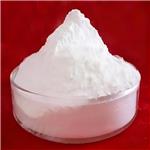Uses
Carboxypeptidase B from Sigma has been used as a reference for assaying carboxypeptidase activity in lysed pituitary granules derived from the anterior and intermediate lobes of rat. The enzyme has also been used to digest plasma samples by removing C-terminal basic amino acids, to get a distinct band for each allotype during C4 electrophoresis.
Uses
The enzyme from Sigma has been used to develop homogeneous time-resolved fluorescence (HTRF) assay for measuring carboxypeptidase B activity in a miniaturized high-throughput screening format. It has been used to evaluate the impact of the C-terminal lysine(s) in human plasminogen binding to
Bifidobacterium. The effect of treatment with carboxypeptidase B, which is a C-terminal lysine-specific endopeptidase, is measured using flow cytometry analysis.
General Description
Native carboxypeptidase B catalyzes the release of C-terminal from basic amino acids, arginine, lysine, or ornithine from polypeptides. Inhibited by EDTA and other Zn
2+ chelators.
Biochem/physiol Actions
Carboxypeptidase B is a proteolytic enzyme capable of rapidly hydrolyzing peptide bonds to release certain carboxyl-terminal basic amino acids from peptides and proteins. Its molecular mass is 34,300±600 Da. It contains one non-dialyzable gram atom of zinc per mole. The enzyme activity is inhibited by metal chelating agents 1, 10-phenanthroline, 8-hydroxyquinoline-5-sulfonic acid, and 2,2′-dipyridyl.




